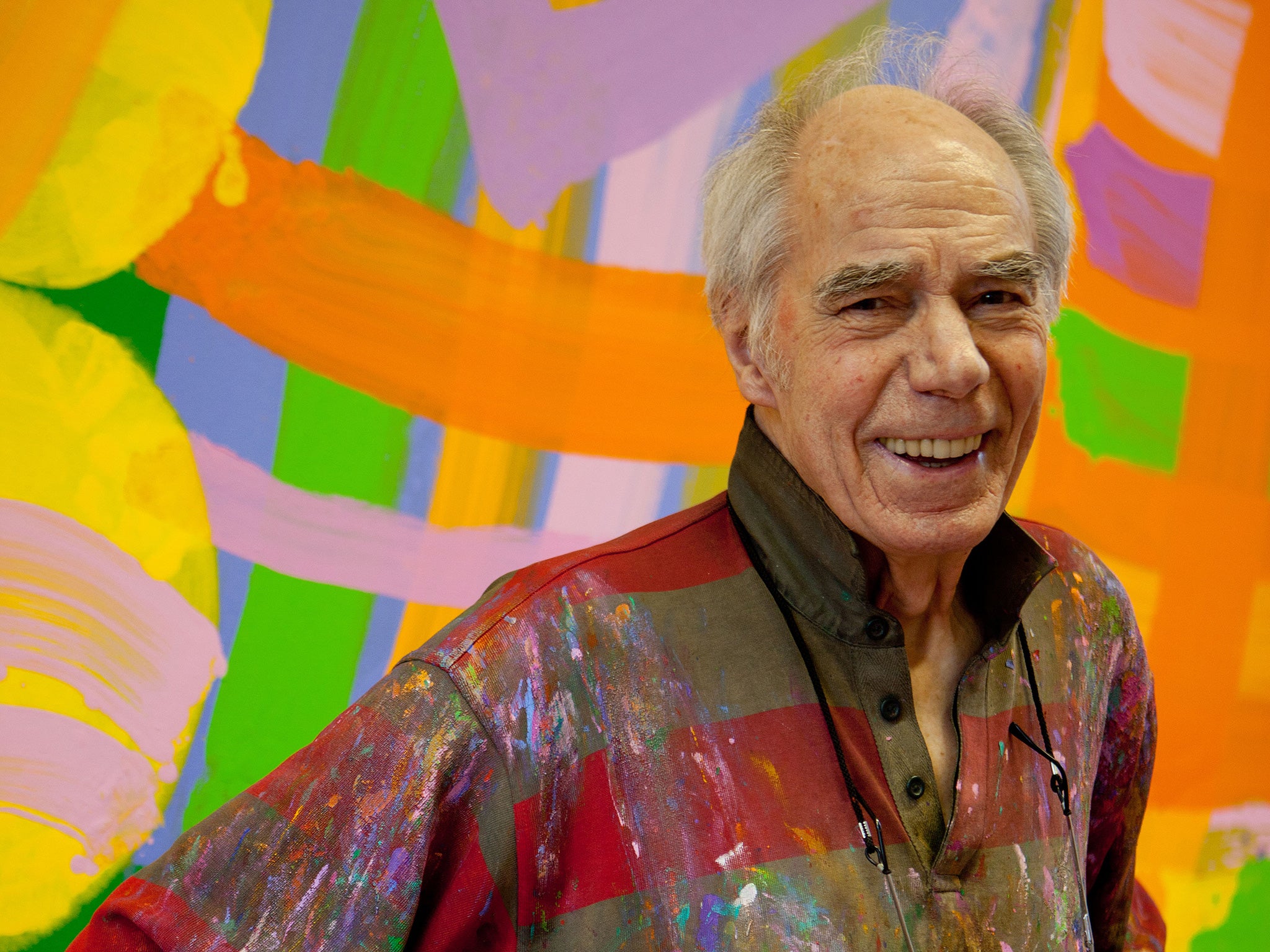Albert Irvin: Artist of boundless energy whose large, abstract canvases were celebrations of colour and the sheer joy of painting
He continued to produce vigorous, fresh pictures into his nineties

The almost immodestly large canvases of the artist Albert Irvin seem to explode and flower in celebrations of colour and in the sheer joy and drama of painting, and although he always reflected on his work before starting, the pictures are wonderfully spontaneous and confident. The lines, blocks, circles and intersections which appear in his work like features on some sort of psychedelic map – and indeed many of his pictures have London-inspired place names – are always subtly organised so as to satisfy the eye.
They are also extraordinarily fresh. Irvin was a tall, good-looking man with boundless energy who never looked his age: his late pictures were so astonishingly vigorous and fresh that one might have guessed them the work of a young man in a hurry although they were when he was actually in his nineties.
Albert Irvin – he was always known as Bert – was born in Bermondsey in 1922, the son of a grocer, but the family moved to north London when he and his brother were young. Highbury, Arsenal FC’s stadium, could be seen from the house, and Irvin’s allegiance to his club was ardent and lifelong. After attending his local grammar school, Irvin was evacuated to Northampton on the outbreak of war from where he won a scholarship to study at Northampton School of Art.
A meeting with the Reverend Walter Hussey was an inspiration to him: Hussey was a significant patron of the arts and he commissioned work by artists such as Henry Moore and Graham Sutherland for his parish church in Northampton. In 1941, only a year into his studies, Irvin was conscripted into the RAF. After training as a navigator in Canada he flew with Fighter Bomber 236 Squadron on raids over the Germany.
At the end of the war, Irvin was accepted for a place at Goldsmith’s College in south-east London and graduated in 1950 with a National Diploma in Design. He took on various teaching posts, including one at Wandsworth prison, while all the time supported by an income from his wife, Betty, who had a regular part-time job; in 1962 he returned to teach at Goldsmith’s where he taught for 20 years.
Irvin’s 1950s work was influenced by Walter Sickert and the contemporary “Kitchen Sink School” of rather anguished realism. The turning point in his thinking came at an exhibition of American artists at the Tate Gallery in 1956 where, for the first time, he experienced the full impact of Abstract Expressionism. Artists such as Jackson Pollock, Mark Rothko, Clyfford Still and Willem de Kooning were a revelation.
A year later he met the St Ives artist Peter Lanyon, whose landscapes came very close to abstraction, and Irvin’s own work gradually became liberated from the necessity of the figurative (even if the occasional “image” might still continue to appear). Together with his colleagues and students at Goldsmith’s he was excited by the work they saw coming from America; he compared abstract painting to classical music – “it was possible to say what it felt like to be a human being without having to paint noses and feet.”
In 1968 Irvin took a studio at St Katherine’s Dock with Bridget Riley, Basil Beattie and others. The group moved to Stepney Green, where they took over a former Jewish school as a collective (Irvin wanted to call it the Fine Art Revolutionary Trust, or FART for short).
In the late 1970s he started to use acrylic and gouache, which were thinner, instead of oils, and he also started screen-printing. If success had come gradually, Irvin’s career now prospered, especially after 1980, when he first showed in the Hayward Annual and the Gimpel Fils gallery in Mayfair began to represent his work. The Tate Gallery bought a work in 1982 and in the same year he was a prize-winner in the John Moore’s Exhibition.
From then on Irvin exhibited widely in the United Kingdom and overseas. He is represented in, among many others, the collections of the Arts Council of Great Britain, Chase Manhattan Bank, Contemporary Art Society, Manchester and Birmingham City Art Galleries and the Victoria and Albert Museum.
Overseas collections include the Art Gallery of New South Wales in Sydney and the Irish Museum of Modern Art in Dublin. Private collectors have included Damian Hirst (“I won’t hear a word against him”), as well as Duran Duran’s Simon Le Bon and his wife Yasmin, who became close friends.
Irvin was elected to the London Group in 1965, to the Royal Academy in 1998, and became an Honorary Member of the Royal West of England Academy in 1999. He was appointed OBE in 2013. He was a warm, friendly, and optimistic man. He always wore denims and brightly coloured trainers and socks. He was also intensely musical.
In 2012 a short film was made for his 90th birthday; he was making works celebrating the values of love and hope to which he aspired. He reflected on his age: “It’s payback time. I gave Betty my youth, I’m giving her back my old age.” His wife of nearly 70 years can be heard laughing in the background.
Albert Henry Thomas Irvin, artist and teacher: born London 21 August 1922; married 1947 Beatrice Nicolson (two daughters); died London 26 March 2015.
Subscribe to Independent Premium to bookmark this article
Want to bookmark your favourite articles and stories to read or reference later? Start your Independent Premium subscription today.

Join our commenting forum
Join thought-provoking conversations, follow other Independent readers and see their replies